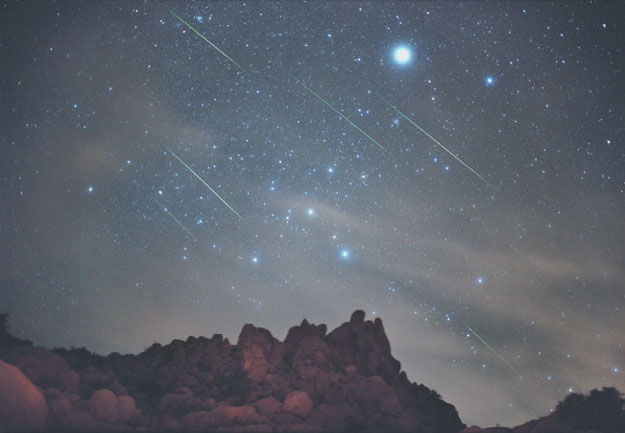Credit & Copyright: Wally Pacholka (Astropics) &
Tony Hallas (Astrophoto)
Explanation:
This year's
Leonid Meteor Shower is predicted to have two peaks,
like last year's.
The first peak should come at about 04:00 hours
Universal Time (UT) on November 19 and be
primarily visible from
Western Europe before sunrise.
The second peak is predicted to occur at about
10:30 UT and be primarily visible from
North America before local sunrise.
During these times, the Leonid Meteor Shower might well develop into a
true meteor storm,
with rates possibly exceeding those measured during
last year's storm.
The meteors in these two peaks come from sand-sized particles
ejected from
Comet Tempel-Tuttle
during trips to the inner
Solar System in 1767 and 1866, respectively.
If you're
stuck without a view you can still
catch the shower by looking for
streaks
caught
by
the
web
cameras of the
Night Sky Live Project.
Pictured above are several
meteors from the
2001 Leonids streaking over
Joshua Tree National Park in
California,
USA.
1999 2000 2001 2002 2003 2004 2005 2006 2007 2008 2009 2010 2011 2012 2013 2014 2015 2016 2017 2018 2019 2020 2021 2022 2023 2024 2025 |
Январь Февраль Март Апрель Май Июнь Июль Август Сентябрь Октябрь Ноябрь Декабрь |
NASA Web Site Statements, Warnings, and Disclaimers
NASA Official: Jay Norris. Specific rights apply.
A service of: LHEA at NASA / GSFC
& Michigan Tech. U.
|
Публикации с ключевыми словами:
Leonids - Leonids 2001 - Леониды
Публикации со словами: Leonids - Leonids 2001 - Леониды | |
См. также:
Все публикации на ту же тему >> | |
